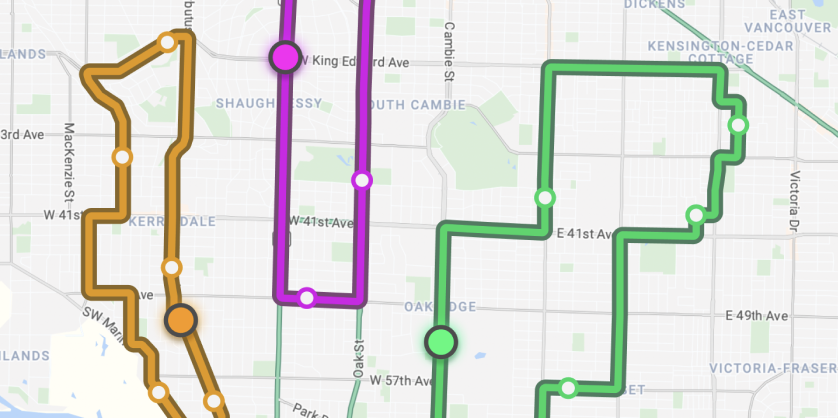Route Optimization 是一种 Google Maps Platform API,可为单辆或多辆车辆及其经停点生成优化的路线方案。
为何使用 Route Optimization API
借助路线规划,提高运输车队的运营效率。您可以根据成本、时间限制、客户需求和任何其他业务目标调整路线。例如:

- 物流公司可以通过安排次日发货来节省时间和资源,同时优化配送,以提高时间效率、节省成本、确保按时送达,并提高司机和最终客户的满意度。
- 一家按需送餐公司可以选择最合适的空闲司机来接取新订单,并将其插入到现有路线中,从而使调度流程更快、更高效。
- 现场服务提供商可以通过以下方式提高效率和客户满意度:为预约分配提供商,为多个预约找到最佳停靠顺序,同时在出现问题时重新优化路线。
您可以使用 Route Optimization API 执行的操作
使用 Route Optimization API 根据您自己的目标和限制条件优化车队的路线和任务分配。
- 目标:您的业务目标。
- 限制:实体资产的限制。
| 目标 | 限制 | ||
|---|---|---|---|
| 出行效率 | 使用距离和到达目的地所需的时间等参数优化基本出行路线。 | 司机工作时间 | 根据驾驶员的工作时间和休息时间为其分配路线。 |
| 准时到达 | 优先安排取件、送货或服务,以便在特定时间之前完成。 | 车辆容量 | 根据车辆的载货量为任务分配车辆。 |
| 车辆使用费 | 尽可能减少执行任务所需的车辆数量。 | 时间窗口 | 在特定时间段内送达货件或完成任务。 |
| 负载均衡 | 在整个车队和人员中公平分配任务。 | 依赖项和兼容性 | 根据车辆类型、任务顺序或货运条件优化车队路线。 |
Route Optimization API 的运作方式
可以使用 REST、gRPC 和客户端库访问路线优化 API。
请求正文
请求正文接受有关您的货件和可用于配送货件的车辆的信息。这包括以下详细信息:
- 自提和配送地点
- 时间窗口
- 货件尺寸和重量
- 车辆容量
响应正文
响应正文会提供详细的路线规划,包括:
- 停靠顺序
- 已分配的货件
- 总体指标
如需详细了解如何构建请求,请参阅构建请求消息;如需详细了解如何解读响应,请参阅解读响应。
资源
下表汇总了可通过路线优化 API 获取的资源及其返回的数据。
| 数据资源 | 说明和返回的数据 | 返回格式 |
|---|---|---|
optimizeTours
|
此方法会返回优化后的路线,其中包含访问和指标的详细信息。 | JSON 或 gRPC proto |
batchOptimizeTours
|
此方法会返回长时间运行的操作的资源名称,用于指示处理何时完成。 | JSON 或 gRPC proto |
如何使用 Route Optimization API
| 1 | 开始设置 | 首先,请设置 Google Cloud 项目,然后按照后续的设置说明完成操作。 |
| 2 | 运行基本请求并接收响应 | 设置完成后,首先按照构建请求和解读响应中的说明发送基本请求并获取响应。 |
| 3 | 尝试更高级的场景并开始创建自己的请求 | 从取货和送货站顺序优化开始探索示例场景,并开始构建符合您使用情形的请求。 |
可用的客户端库
如需查看 Route Optimization API 的可用客户端库列表,请参阅客户端库。
后续步骤
- 开始使用 Route Optimization API:前往运行基本请求。
- 了解结算:用量和结算
- 查看示例代码和库:客户端库和开源。
- 遵循最佳实践:使用 Route Optimization API Web 服务的最佳实践

